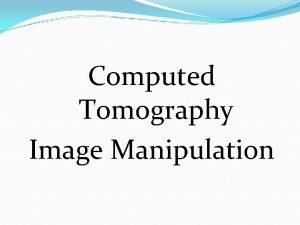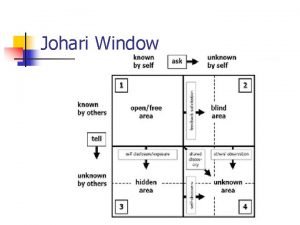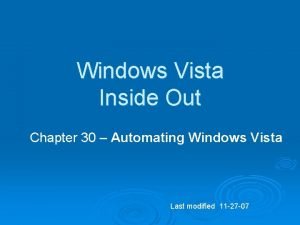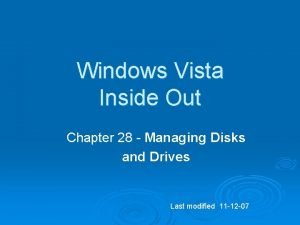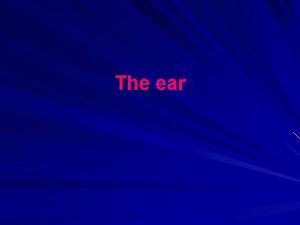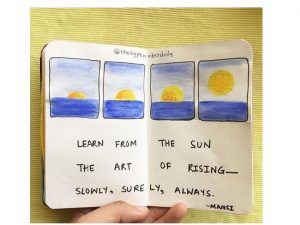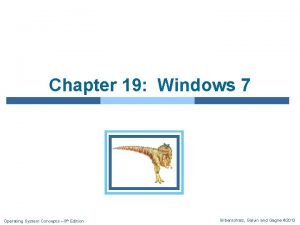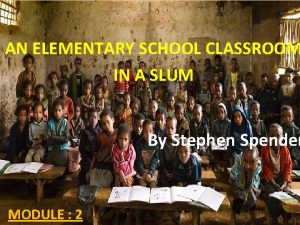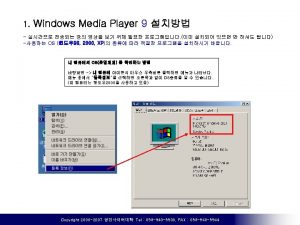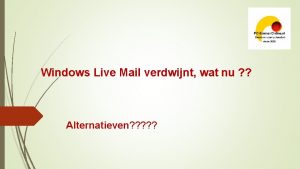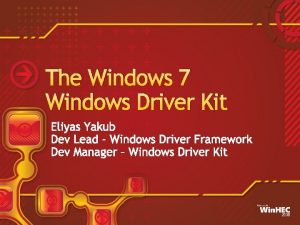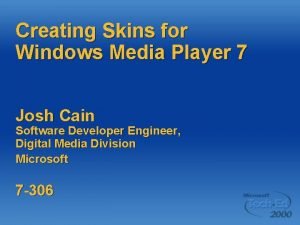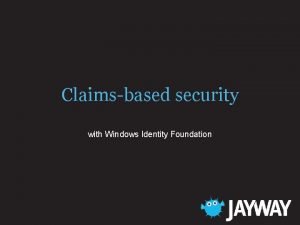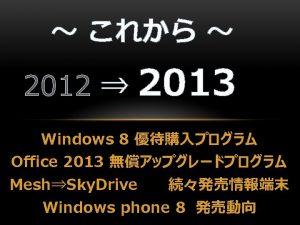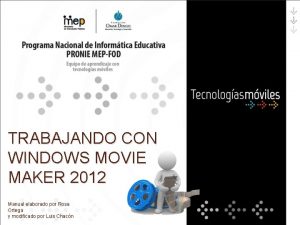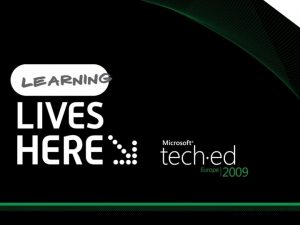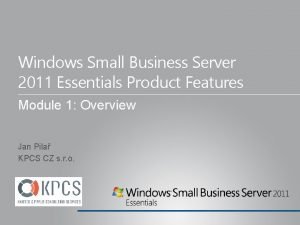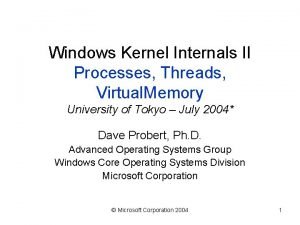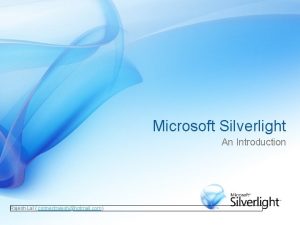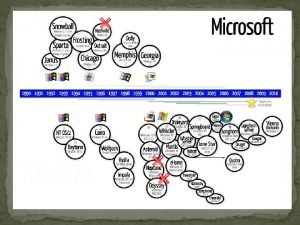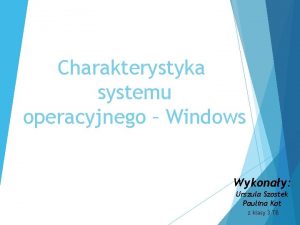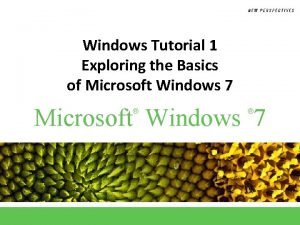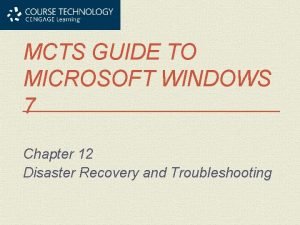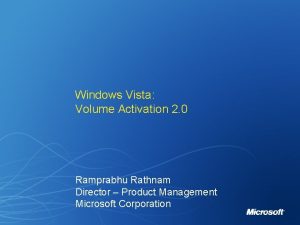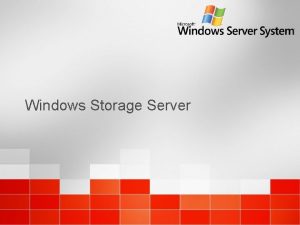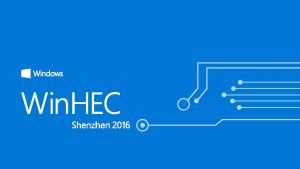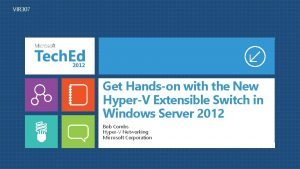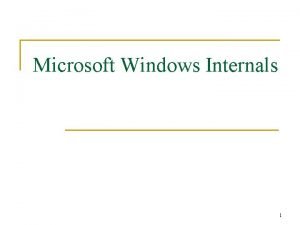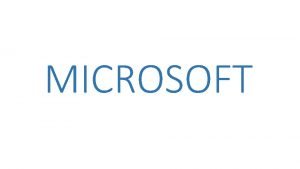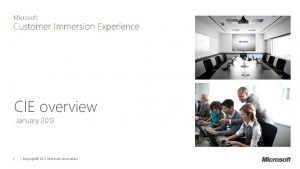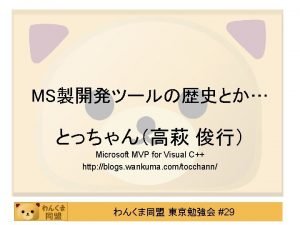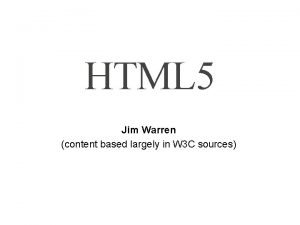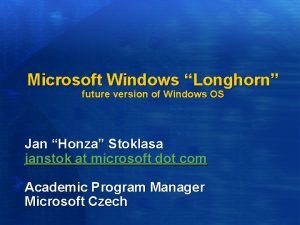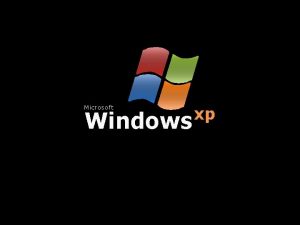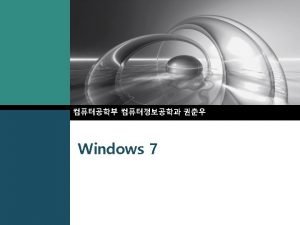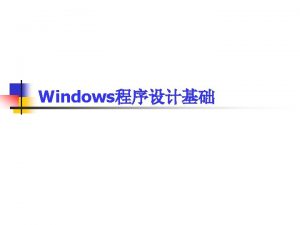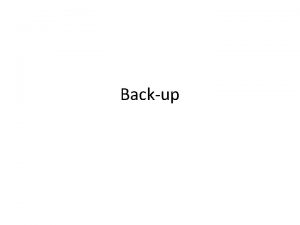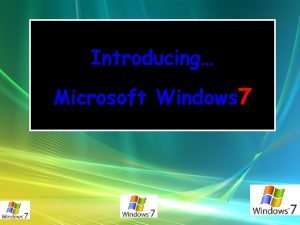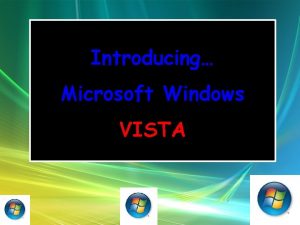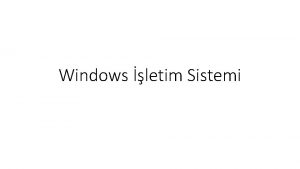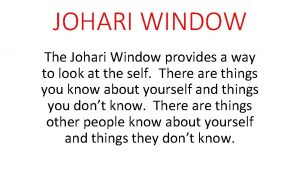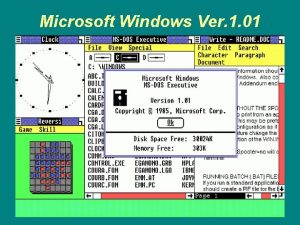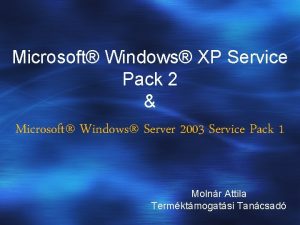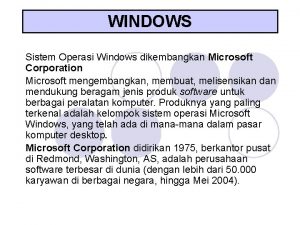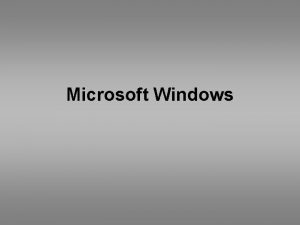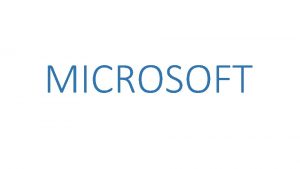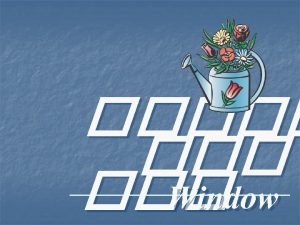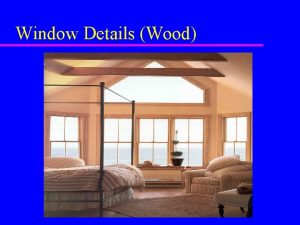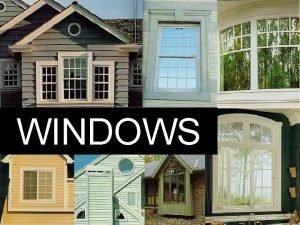Window Management Window Management Microsoft Windows also provides
















































- Slides: 48

Window Management

Window Management • Microsoft Windows also provides several window management schemes, • a single document interface, • a multiple-document interface, • workbooks, and • projects. • These window management schemes are not exclusive design techniques. • They may be combined, or others developed. • These techniques, however, are the most frequently used schemes.

Window Management Single-Document Interface A single primary window with a set of secondary windows. ■ Proper usage: — Where object and window have a simple, one-to-one relationship. — Where the object’s primary presentation or use is as a single unit. — To support alternate views with a control that allows the view to be changed. • — To support simultaneous views by splitting the window into panes. Advantage. • — Window manipulation is easier and less confusing. • ■ Disadvantage: • — Information is displayed or edited in separate windows. • • •

Window Management • • • • • Multiple-Document Interface — A technique for managing a set of windows where documents are opened into windows. • A single primary window, called the parent. • A set of related document or child windows, — Each child window is constrained to appear only within the parent window. — The child windows share the parent window’s operational elements. — The parent window’s elements can be dynamically changed to reflect the requirements of the active child window. usage: — To present multiple occurrences of an object. — To compare data within two or more windows. — To present multiple parts of an application. — Best suited for viewing homogeneous object types. Advantages: — The child windows share the parent window’s interface components (menus, toolbars, and status bars), making it a very space-efficient interface. — Useful for managing a set of objects. — Provides a grouping and focus for a set of activities within the larger environment of the desktop.

Window Management • Workbooks • — A window or task management technique that consists of a set of views organized like a tabbed notebook. • — It is based upon the metaphor of a book or notebook. • — Views of objects are presented as sections within the workbook’s primary windows; child windows do not exist. • — Each section represents a view of data. • — Tabs can be included and used to navigate between sections. • — Otherwise, its characteristics and behavior are similar to those of the multiple document interface with all child windows maximized. • usage: • — To manage a set of views of an object. • — To optimize quick navigation of multiple views. • — For content where the order of the sections is significant.

Window Management • • • • Projects — A technique that consists of a container: a project window holding a set of objects. — The objects being held within the project window can be opened in primary windows that are peers with the project window. — Visual containment of the peer windows within the project window is not necessary. — Each opened peer window must possess its own menu bar and other interface elements. — Each opened peer window can have its own entry on the task bar. — When a project window is closed, all the peer windows of objects also close. — When the project window is opened, the peer windows of the contained objects are restored to their former positions. — Peer windows of a project may be restored without the project window itself being restored. ■ usage: — To manage a set of objects that do not necessarily need to be contained. — When child windows are not to be constrained. ■ Advantages: — Provides a grouping and focus for a set of activities within the larger environment of the desktop. — Preserves some management capabilities of the multiple document interface. — Provides the greatest flexibility in the placement and arrangement of windows.

Organizing Window Functions • Information and functions must be presented to people when and where they need them. • Proper organization and support of tasks by windows will only be derived through a thorough and clear analysis of user tasks.

Organizing Window Functions • • • • Window Organization ■ Organize windows to support user tasks. ■ Support the most common tasks in the most efficient sequence of steps. ■ Use primary windows to: — Begin an interaction and provide a top-level context for dependent windows. ■ Use secondary windows to: — Extend the interaction. — Obtain or display supplemental information related to the primary window. ■ Use dialog boxes for: — Infrequently used or needed information. — “Nice-to-know” information. People most often think in terms of tasks, not functions or applications. Windows must be organized to support this thinking

Organizing Window Functions • Number of Windows • ■ Minimize the number of windows needed to accomplish an objective. • A person does not work with windows simply for the joy of working with windows. • Multiple windows on a display, as discussed elsewhere in this text, can be confusing, can increase the load on the human visual system, or may be too small to effectively present what needs to be contained within them. • Guidelines that appeared in early stages of window evolution concerning the maximum number of windows that a person could deal with were quite generous, a limit of seven or eight being suggested. • As experience with windows has increased, these numbers have gradually fallen. • One study found the mean number of windows maintained for experienced users was 3. 7. • Today, based on expressions of window users, a recommendation of displaying no more than two or three at one time seems most realistic.

Organizing Window Functions • Number of Windows • The guidelines on limitations for items like cascades (1– 2) reflect today’s feelings. • The exact number of windows a person can effectively deal with at one time will ultimately depend on both the capabilities of the user and the characteristics of the task. • Some users and situations may permit handling of more than three windows; for other users and situations, three windows may be two too many. • The general rule: Minimize the number of windows used to accomplish an objective. • Use a single window whenever possible. Consider, however, the user’s task. • Don’t clutter up a single window with rarely used information when it can be placed on a second, infrequently used, window.

Window Operations • Guidelines for windows operations are still evolving. • Because of the paucity of published research data, many of the guidelines are still more anecdotal and intuitive than scientific. • Guidelines will continue to develop and change as our understanding of, and experiences with, the windows interface continue to increase. • Today, the following operational guidelines seem appropriate.

Window Operations • • • Active Window ■ A window should be made active with as few steps as possible. ■ Visually differentiate the active window from other windows. While a system supports the display of multiple windows, the user generally works within a single window at one. This window, called the active window, may be designated either by the system or the user. Many systems make a window active when it is the object of another windowing operation. Visually differentiate the active window from other windows. It is important that the user be able to quickly identify the active window. Methods to do this include a contrasting window title bar, border, or background color. An “active” indicator in the window border, which is turned on or off, may also be used.

Window Operations • General Guidelines • ■ Design easy to use and learn windowing operations. • — Direct manipulation seems to be a faster and more intuitive interaction style than indirect manipulation for many windowing operations. • ■ Minimize the number of window operations necessary to achieve a desired effect. • ■ Make navigating between windows particularly easy and efficient to do. • ■ Make the setting up of windows particularly easy to remember. • ■ In overlapping systems, provide powerful commands for arranging windows on the screen

Window Operations • • • • Opening a Window ■ Provide an iconic representation or textual list of available windows. — If opening with an expansion of an icon, animate the icon expansion. ■ When opening a window: — Position the opening window in the most forward plane of the screen. — Adapt the window to the size and shape of the monitor on which it will be presented. — Designate it as the active window. — Set it off against a neutral background. — Ensure that its title bar is visible. ■ When a primary window is opened or restored, position it on top. — Restore all secondary windows to the states that existed when the primary window was closed. ■ When a dependent secondary window is opened, position it on top of its associated primary window. — Position a secondary window with peer windows on top of its peers. — Present layered or cascaded windows with any related peer secondary windows.

Window Operations • • • Sizing Windows ■ Provide large-enough windows to: — Present all relevant and expected information for the task. — Avoid hiding important information. — Avoid crowding or visual confusion. — Minimize the need for scrolling. • But use less than the full size of the entire screen. ■ If a window is too large, determine: — Is all the information needed? — Is all the information related? ■ Otherwise, make the window as small as possible. — Optimum window sizes:

Window Operations • • • • • Window Placement — In placing a window on the display, consider: • The use of the window. • The overall display dimensions. • The reason for the window’s appearance. ■ General: — Position the window so it is entirely visible. — If the window is being restored, place the window where it last appeared. — If the window is new, and a location has not yet been established, place it: • At the point of the viewer’s attention, usually the location of the pointer or cursor. • A cascading presentation is recommended. — In a multiple-monitor configuration, display the secondary window on the same monitor as its primary window. — If none of the above location considerations apply, then: • Horizontally center a secondary window within its primary window just below the title bar, menu bar, and any docked toolbars. — If the user then moves the window, display it at this new location the next time the user opens the window. • Adjust it as necessary to the current display configuration. — Do not let the user move a window to a position where it cannot be easily repositioned. ■ Dialog boxes: — If the dialog box relates to the entire system, center it on screen.

Window Operations • • • Window Separation ■ Crisply, clearly, and pleasingly demarcate a window from the background of the screen on which it appears. — Provide a surrounding solid line border for the window. — Provide a window background that sets the window off well against the overall screen background. — Consider incorporating a drop shadow beneath the window. Component separation is especially critical in a graphics environment because of the spatial layering that can occur. All windows must be clearly set off from the underlying screen or windows. Also provide a window background that sets the window off well against the overall screen background. If color is used, exercise caution and choose compatible colors Another alternative is to use for the window a lighter shade of the color used for the screen background. Changes in the density of shades are often more visually pleasing than different colors. To emphasize three-dimensional aspects of graphic windows, incorporate a drop shadow beneath each window.

Window Operations • Moving a Window • ■ Permit the user to change the position of all windows. • ■ Change the pointer shape to indicate that the move selection is successful. • ■ Move the entire window as the pointer moves. • — If it is impossible to move the entire window, move the window outline while leaving the window displayed in its original position. • ■ Permit the moving of a window without its being active.

Window Operations • Resizing a Window • ■ Permit the user to change the size of primary windows. • — Unless the information displayed in the window is fixed or cannot be scaled to provide more information. • ■ Change the pointer shape to indicate that the resizing selection is successful. • ■ The simplest operation is to anchor the upper-left corner and resize from the lowerright corner. • — Also permit resizing from any point on the window. • ■ Show the changing window as the pointer moves. • — If it is impossible to show the entire window being resized, show the window’s outline while leaving the window displayed in its original position. • ■ When window size changes and content remains the same: • — Change image size proportionally as window size changes.

Window Operations • Other Operations • ■ Permit primary windows to be maximized, minimized, and restored. • Maximizing a window increases the size of the window to its largest optimum size. • The system default setting for the maximum size is as large as the display. • This should be adjustable, as necessary. • Minimizing a window reduces it to its smallest size. • Restoring returns a window to its previous size and position after the user has maximized or minimized it.

Window Operations • Window Shuffling • Window shuffling should be easy to perform in as few steps as possible. • One method is to permit the toggling of the two most recently displayed windows. • Another is to permit rapid window shuffling and the swapping of the front window and the second or back window.

Window Operations • Keyboard Control/Mouseless Operation • ■ Window actions should be capable of being performed through the keyboard as well as with a mouse. • ■ Keyboard alternatives should be designated through use of mnemonic codes as much as possible. • ■ Keyboard designations should be capable of being modified by the user. • All window actions should be capable of being performed using the keyboard as well as the mouse.

Window Operations • • • Closing a Window ■ Close a window when: — The user requests that it be closed. — The user performs the action required in the window. — The window has no further relevance. ■ If a primary window is closed, also close all of its secondary windows. ■ When a window is closed, save its current state, including size and position, for use when the window is opened again. Close a window when the user requests it to be closed, when the action required in the window is performed, or when the window has no further relevance to the task being performed. If the closed window is a primary window, also close its associated secondary windows. When a window is closed, it is important that its current state, including size and position, be saved for use when the window is again opened.

Web Systems • Web systems have limited windowing capabilities. • The frame concept does provide window-like ability, and Java. Script does provide pop-up windows. • Frames • — Multiple Web screen panes that permit the displaying of multiple documents on a page. • — These documents can be independently viewed, scrolled, and updated. • — The documents are presented in a tiled format. • usage: • — For content expected to change frequently. • — To allow users to change partial screen content. • — To permit users to compare multiple pieces of information.

Web Systems • Pop-Up Windows • Java. Script pop-up windows began appearing on the Web in 1996. • Their use is multiplying and, in the view of almost all Web users, polluting screens. • Because they are most frequently used in advertising, they have become a source of great aggravation to almost every user. • Anecdotal evidence suggests that when a pop-up window begins to appear, most people close them before they are rendered. • So, if a pop-up window is used, it may never be completely seen or read by the user. • Use them with extreme caution.

Device-Based Controls

Device-Based Controls • Device-based controls, often called input devices, are the mechanisms through which people communicate their desires to the system. The evolution of graphical systems has seen a whole new family of devices provided to assist and enhance this communication. • These new mechanisms are most commonly referred to as pointing devices. In this step, we will: • Identify the characteristics and capabilities of various device-based controls: • Trackball • Joystick • Graphic tablet • Light pen • Touch screen • Voice • Mouse • Keyboard • Select the proper controls for the user and tasks.

Characteristics of Device-Based Controls • • • • Several specific tasks are performed using graphical systems. To point at an object on the screen. To select the object or identify it as the focus of attention. To drag an object across the screen. To draw something free form on the screen. To track or follow a moving object. To orient or position an object. To enter or manipulate data or information. The various devices vary in how well they can perform these actions. Among the considerations to be reviewed are two very important factors. First, is the mechanism a direct or indirect pointing device? Direct devices are operated on the screen itself. Examples include the light pen, the finger, and voice. Indirect devices are operated in a location other than the screen, most often on the desktop. Examples include the mouse, trackball, and keyboard. The psychomotor skills involved in learning to use, and using, a direct device are much simpler than those required for an indirect device.

Characteristics of Device-Based Controls • Second, in terms of direction, distance, and speed, what is the relationship between movement of the hand-operated device and the corresponding pointer movement on the screen? Does the pointer movement track control movement exactly or does it not? • The mouse achieves a coupled relationship in all three aspects of direction, distance, and speed:

Characteristics of Device-Based Controls • • • • • Trackball — A spherical object (ball) that rotates freely in all directions in its socket. — Direction and speed is tracked and translated into cursor movement. ■ Advantages: — Direct relationship between hand pointer movement in terms of direction and speed. — Does not obscure vision of screen. — Does not require additional desk space (if mounted on keyboard). ■ Disadvantages: — Movement is indirect, in a plane different from the screen. — No direct relationship exists between hand pointer movement in terms of distance. — Requires a degree of eye-hand coordination. — Requires hand to be removed from keyboard keys. — Requires different hand movements. — Requires hand to be removed from keyboard (if not mounted on keyboard). — Requires additional desk space (if not mounted on keyboard). — May be difficult to control. — May be fatiguing to use over extended time.

Characteristics of Device-Based Controls • • • • • • Joystick — A stick or bat-shaped device anchored at the bottom. — Variable in size, smaller ones being operated by fingers, larger ones requiring the whole hand. — Variable in cursor direction movement method, force joysticks respond to pressure, movable ones respond to movement. — Variable in degree of movement allowed, from horizontal-vertical only to continuous. ■ Advantages: — Direct relationship between hand pointer movement in terms of direction. — Does not obscure vision of screen. — Does not require additional desk space (if mounted on keyboard). ■ Disadvantages: — Movement indirect, in plane different from screen. — Indirect relationship between hand pointer in terms of speed and distance. — Requires a degree of eye-hand coordination. — Requires hand to be removed from keyboard keys. — Requires different hand movements to use. — Requires hand to be removed from keyboard (if not mounted on keyboard). — Requires additional desk space (if not mounted on keyboard). — May be fatiguing to use over extended time. — May be slow and inaccurate.

Characteristics of Device-Based Controls • • • • • Graphic Tablet ■ Description: — Pressure-, heat-, light-, or light-blockage-sensitive horizontal surfaces that lie on the desktop or keyboard. — May be operated with fingers, light pen, or objects like a stylus or pencil. — Pointer imitates movements on tablet. ■ Advantages: — Direct relationship between touch movements and pointer movements in terms of direction, distance, and speed. — More comfortable horizontal operating plane. — Does not obscure vision of screen. ■ Disadvantages: — Movement is indirect, in a plane different from screen. — Requires hand to be removed from keyboard keys. — Requires different hand movements to use. — Requires additional desk space. — Finger may be too large for accuracy with small objects

Characteristics of Device-Based Controls • • • • • • Touch Screen ■ Description: — A special surface on the screen sensitive to finger or stylus touch. ■ Advantages: — Direct relationship between hand pointer location in terms of direction, distance, and speed. — Movement is direct, in the same plane as screen. — Requires no additional desk space. — Stands up well in high-use environments. ■ Disadvantages: — Finger may obscure part of screen. — Finger may be too large for accuracy with small objects. — Requires moving the hand far from the keyboard to use. — Very fatiguing to use for extended period of time. — May soil or damage the screen. ■ Design Guidelines: — Screen objects should be at least 3/4″ × 3/4″ in size. — Object separation should be at least 1/8″. — Provide visual feedback in response to activation. Auditory feedback may also be appropriate. — When the consequences are destructive, require confirmation after selection to eliminate inadvertent selection. — Provide an instructional invitation to begin using.

Characteristics of Device-Based Controls • Light Pen • ■ Description: • — A special surface on a screen sensitive to the touch of a special stylus or pen. • ■ Advantages: • — Direct relationship between hand pointer movement in terms of direction, • distance, and speed. • — Movement is direct, in the same plane as screen. • — Requires minimal additional desk space. • — Stands up well in high-use environments. • — More accurate than finger touching. • ■ Disadvantages: • — Hand may obscure part of screen. • — Requires picking it up to use. • — Requires moving the hand far from the keyboard to use. • — Very fatiguing to use for extended period of time.

Characteristics of Device-Based Controls • • • • Voice ■ Description: — Automatic speech recognition by the computer. ■ Advantages: — Simple and direct. — Useful for people who cannot use a keyboard. — Useful when the user’s hands are occupied. Disadvantages: — High error rates due to difficulties in: • Recognizing boundaries between spoken words. • Blurred word boundaries due to normal speech patterns. — Slower throughput than with typing. — Difficult to use in noisy environments. — Impractical to use in quiet environments.

Characteristics of Device-Based Controls • • • • • Mouse ■ Description: — A rectangular or dome-shaped, movable, desktop control containing from one to three buttons used to manipulate objects and information on the screen. — Movement of screen pointer mimics the mouse movement. ■ Advantages: — Direct relationship between hand pointer movement in terms of direction, distance, and speed. — Permits a comfortable hand resting position — Selection mechanisms are included on mouse. — Does not obscure vision of the screen. ■ Disadvantages: — Movement is indirect, in a plane different from screen. — Requires hand to be removed from keyboard. — Requires additional desk space. — May require long movement distances. — Requires a degree of eye-hand coordination.

Characteristics of Device-Based Controls • • • • • • Keyboard ■ Description: — Standard typewriter keyboard and cursor movement keys. ■ Advantages: — Familiar. — Accurate. — Does not take up additional desk space. — Very useful for: • Entering text and alphanumeric data. • Inserting in text and alphanumeric data. • Keyed shortcuts—accelerators. • Keyboard mnemonics—equivalents. — Advantageous for: • Performing actions when less than three mouse buttons exist. • Use with very large screens. • Touch typists. ■ Disadvantages: — Slow for non-touch-typists. — Slower than other devices in pointing. — Requires discrete actions to operate. — No direct relationship between finger or hand movement on the keys and cursor movement on screen in terms of speed and distance.

Screen Device-Based Controls

Screen Device-Based Controls • Keyboard versus Mouse • Why do many skilled typists prefer a keyboard to a mouse? Speed is obviously one reason. • An experienced typist, through kinesthetic memory, has memorized the locationof keyboard keys. The keying process becomes exceptionally fast and well learned. The • mouse is slower, and it has a tendency to move about the desk. Its location cannot be • memorized. The keyboard keys always remain in the same spot. • Consider the following: When using the mouse, the time to move one’s hand from • the keyboard, grasp the mouse, and point at a screen object ranges from 1. 5 to 2 seconds. • A very skilled typist can type 13 to 15 characters in that amount of time; an average typist • can type 4 to 6 characters. No wonder the keyboard is often preferred.

Screen Device-Based Controls • • • • • Control Research Which devices work better for which tasks and under what conditions has been addressed by a number of investigators. A survey of the research literature comparing and evaluating different devices yields the following summarization concerning tasks involving pointing and dragging: The fastest tools for pointing at stationary targets on screens are the devices that permit direct pointing: the touch screen and light pen. This is most likely due to their high level of eye-hand coordination and because they use an action familiar to people. In terms of positioning speed and accuracy for stationary targets, the indirect pointing devices—the mouse, trackball, and graphic tablet, do not differ greatly from one another. The joystick is the slowest, although it is as accurate as the others. Of most importance in selecting one of these devices will be its fit to the user’s task and working environment. A separate confirmation action that must follow pointer positioning increases pointing accuracy but reduces speed. The mouse offers a very effective design configuration for tasks requiring this confirmation. For tracking small, slowly moving targets, the mouse, trackball, and graphic tablet are preferred to the touch screen and light pen because the latter may obscure the user’s view of the target.

Screen Device-Based Controls • • • • • Guidelines for Selecting the Proper Device-Based Control ■ Consider the characteristics of the task. — Provide keyboards for tasks involving: • Heavy text entry and manipulation. • Movement through structured arrays consisting of a few discrete objects — Provide an alternative pointing device for graphical or drawing tasks. The following are some suggested best uses: • Mouse—pointing, selecting, drawing, and dragging. • Joystick—selecting and tracking. • Trackball—pointing, selecting and tracking. • Touch screen—pointing and selecting. • Graphic tablet—pointing, selecting, drawing, and dragging. — Provide touch screens under the following conditions: • The opportunity for training is minimal. • Targets are large, discrete, and spread out. • Frequency of use is low. • Desk space is at a premium. • Little or no text input requirement exists.

Screen Device-Based Controls • • • • • Pointer Guidelines ■ The pointer: — Should be visible at all times. — Should contrast well with its background. — Should maintain its size across all screen locations and during movement. — The hotspot should be easy to locate and see. — Location should not warp (change position). ■ The user should always position the pointer. ■ The shape of a pointer: — Should clearly indicate its purpose and meaning. — Should be constructed of already defined shapes. — Should not be used for any other purpose other than its already defined meaning. — Do not create new shapes for already defined standard functions. ■ Use only as many shapes as necessary to inform the user about current location and status. Too many shapes can confuse a person. ■ Be conservative in making changes as the pointer moves across the screen. — Provide a short “time-out” before making noncritical changes on the screen. ■ Animation should not: — Distract. — Restrict one’s ability to interact.

Operable Controls

Operable Controls • Operable controls are those that permit the entry, selection, changing, or editing of a particular value, or cause a command to be performed. • Classes include buttons, text entry/read-only, selection, combination entry/selection, and other specialized controls.

Operable Controls • • • • • Buttons ■ Description: — A square or rectangular-shaped control with a label inside that indicates action to be accomplished. — The label may consist of text, graphics, or both. ■ Purpose: — To start actions. — To change properties. — To display a pop-up menu. ■ Advantages: — Always visible, reminding one of the choices available. — Convenient. — Can be logically organized in the work area. — Can provide meaningful descriptions of the actions that will be performed. — Larger size generally provides faster selection target. — Can possess 3 -D appearance: • Adds an aesthetically pleasing style to the screen. • Provides visual feedback through button movement when activated. — May permit use of keyboard equivalents and accelerators. — Faster than using a two-step menu bar/pull-down sequence.

Text Boxes ■ Description: — A control, usually rectangular in shape, in which: • Text may be entered or edited. • Text may be displayed for read-only purposes. — Usually possesses a caption describing the kind of information contained within it. • — An outline field border: • • Is included for enterable/editable text boxes. • • Is not included for read-only text boxes. • • •

Text Boxes • • • Two types of text boxes exist. One consists of a rectangular box into which information is typed. It may also be referred to as an edit control. The second is also rectangular in shape but contains text displayed purely for readonly purposes. The former type has historically been referred to as an entry field, the latter as an inquiry or display field. While display-only text boxes are not operable in the true sense of the word, the information contained within them is capable of being modified by other controls. Hence, they will be reviewed as an operable control since their characteristics, and the characteristics of an entry field, are very similar. Some platforms classify both as text boxes. Text boxes almost always possess a separate caption describing the kind of information to be keyed. An enterable text box is visually presented on the screen, its shape being defined by an outline border, a reversal in screen polarity, a white background, or various combinations of these features. The information in a read-only text field is most effectively displayed on the screen background, not in a box. Therefore, a box does not surround the information contained in read-only text boxes.

Text Boxes
 Microsoft windows movie maker windows 7
Microsoft windows movie maker windows 7 Apat na bahagi ng talata
Apat na bahagi ng talata Window width ct
Window width ct Humanmetrics myers briggs
Humanmetrics myers briggs Windows vista inside out
Windows vista inside out Windows vista disk management
Windows vista disk management Air cells
Air cells Oval window and round window
Oval window and round window Window to window chapter 19
Window to window chapter 19 Cramped holes is a metaphor for
Cramped holes is a metaphor for Windows live movie maker add music
Windows live movie maker add music Windows media player 9
Windows media player 9 Windows live mail windows 8
Windows live mail windows 8 Windows driver kit windows 7
Windows driver kit windows 7 Windows media player themes
Windows media player themes Windows identity foundation windows 10
Windows identity foundation windows 10 Windws update
Windws update Xp virtual machine
Xp virtual machine Windows mobile center windows 10
Windows mobile center windows 10 Windows movie maker 2012 windows 7
Windows movie maker 2012 windows 7 Windows vista windows 10
Windows vista windows 10 Windows xp virtualization
Windows xp virtualization Small business server 2010
Small business server 2010 Small business server 2011 end of life
Small business server 2011 end of life Microsoft-windows-kernel-process
Microsoft-windows-kernel-process Silverlight seminar ppt download
Silverlight seminar ppt download Introduccion de microsoft
Introduccion de microsoft Mark overmars gamemaker
Mark overmars gamemaker Microsoft paulina windows 7
Microsoft paulina windows 7 Microsoft windows tutorial
Microsoft windows tutorial Microsoft windows armendicott
Microsoft windows armendicott Microsoft windows logos
Microsoft windows logos Windows startwarren theverge
Windows startwarren theverge Microsoft windows logos
Microsoft windows logos Volume activation management tool download
Volume activation management tool download Microsoft windows storage server 2003
Microsoft windows storage server 2003 Microsoft windows 10 security update
Microsoft windows 10 security update Microsoft windows filtering platform hyper-v
Microsoft windows filtering platform hyper-v Windows microsoft.com
Windows microsoft.com Windows microsoft.com
Windows microsoft.com Windows internals
Windows internals Microsoft windows 2005
Microsoft windows 2005 Microsoft is changing to black windows
Microsoft is changing to black windows Microsoft back against windows
Microsoft back against windows Microsoft windows 3.x
Microsoft windows 3.x Berikut ini yang bukan kegunaan program pengolah angka
Berikut ini yang bukan kegunaan program pengolah angka Microsoft windows startwarren
Microsoft windows startwarren Windows image acquisition driver
Windows image acquisition driver Longhorn api
Longhorn api


